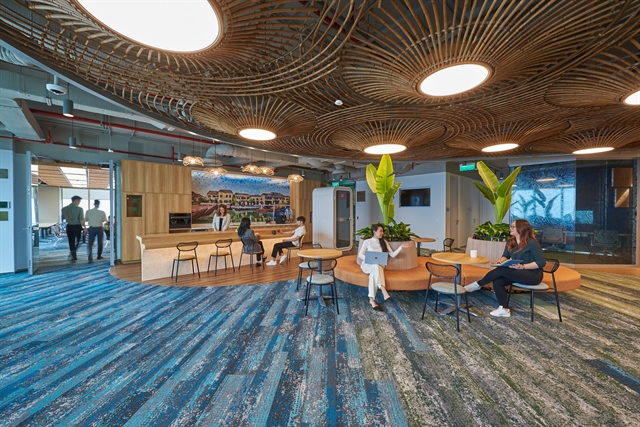 Economy
Economy


|
| A view of Microsoft Việt Nam's new office, which applies a hybrid-working model in Hà Nội. Hybrid-working is remaining popular in the post-pandemic world. — Photo courtesy of the firm |
Vũ Hoa
HÀ NỘI — The hybrid-working model, that is combining 'work-from-home' with more traditional office-based work, has remained popular despite an end to social distancing mandates, experts have said.
In fact, hybrid-working is the preferred working model around the world in the 'new normal', according to Microsoft's Work Trend Index survey.
Microsoft's 2021 survey has taken answers from over 30,000 people in 31 countries and territories around the world.
With a hybrid-working model, employees can choose to work from anywhere and only go to the office when needed. This way of operating allows employees to choose the best working hours for them, and could reduce mental pressures caused by COVID-19, as well as reducing the risk of cross-infection.
Currently, giant technology firms like Microsoft, Google and Facebook have utilised this model, so that employees can flexibly work from home or office.
The model not only brings convenience to employees, but also benefits businesses because it could help reduce operating costs by up to 30 per cent, according to Global Management Consulting firm, McKinsey & Company. With these cost savings, companies can reinvest or build a satellite office to provide employees with more workplace choices. In addition, they could expand resources, recruit talents from all over the world and increase competitiveness when entering the international market.
Tiêu Yến Trinh, CEO of HR consulting company Talentnet, said that although employees are vaccinated to return to the workplace, they could not be subjective and eliminate potential risks. In fact, hybrid-working has been deployed around the world and brought practical results to businesses.
In Việt Nam, this model has not been popular before, but after the period of working from home due to prolonged social distancing, this model could be a popular trend. According to Microsoft's latest report on the trend of "Hybrid Workplace" in Việt Nam, up to 81 per cent of workers want to continue working remotely, especially young Gen Z workers.
In keeping with the trend, Microsoft Việt Nam earlier this week inaugurated its new office, applying the hybrid working model in Việt Nam. Covering an area of over 700sq.m, this is one of the largest Microsoft smart-sites in the world.
The new office will contribute to creating the best conditions for employees to connect and collaborate anytime, anywhere. At the same time, it is an affirmation of Microsoft's long-term commitment to the Vietnamese market.
According to Phan Tú Quyên, Director of Marketing and Operations, Microsoft Vietnam, since the outbreak of the COVID-19 pandemic, Microsoft has implemented a hybrid working model for more than 160,000 employees globally.
"The reality is that work can be done in many different ways and more than ever, flexibility, trust and empowerment are the keys to success," Quyên said.
She believed that the working model is the future trend. To help employees achieve success, businesses will need to reshape the organisation's work model, thereby creating a better working environment and more responsive to the diverse needs of both employees and customers.
According to Microsoft Vietnam, the meeting rooms in its new office are fully equipped with Microsoft Teams built-in devices that support face-to-face and online combined meetings, from LCD screens to electronic whiteboards, cameras and high-quality sound systems, to bring the most authentic experience to meetings.
In particular, the camera can automatically identify the speaker to navigate the angle, enlarge the image of the speaker on the meeting screen, as well as recognise writing on the whiteboard to convert it into an online note board in Teams.
In addition, Microsoft's new office is also equipped with identification sensors to collect data, such as the frequency of people entering and leaving, the number of people meeting in a room, from which to automatically activate meeting features, analyse and adjust light intensity and room temperature.
Towards a Diversity and Inclusion corporate culture model, leaving no one behind, the office is also designed to be friendly to the disabled community. Notably, it equipped a room with support equipment for female employees back to work after their maternity leave.
Talking about the roadmap for businesses to build their own hybrid working model, Quyên told Việt Nam News that: “Microsoft has available technology, so the transition to this model is very fast from policy formulation to building model.”
“Our employees can therefore catch up very quickly with this transformation, making the most of technology for their work process. Microsoft wishes to be able to help customers choose and build their own roadmap. In the process, we and our partners will develop a roadmap, approach, and lessons learned for them,” she added. — VNS
thehrdirector.com - specialising in providing high-end human resources, says that the hybrid-working model is not a trend but the reality of 2022 and the future. It's good for both workers and businesses in the current COVID-19 pandemic. In the hybrid-working model, technology will play a central role. While it may not be perfect for now, remote technologies with platforms that help businesses run online will continue to allow people to connect with friends, family and partners around the world. However, working from home is still challenging. When working remotely, workers often do not have clear boundaries with family life. They face exhaustion, loneliness and even addiction due to psychological problems. In addition, Microsoft's World Trend Index report has shown that not all industries can apply hybrid-working. This model is suitable for several industries, such as technology, media/advertising, design, travel, fashion, cosmetics, home appliances. For industries that require strict confidentiality information, processes such as banks and securities, this model will be difficult to match. — VNS |